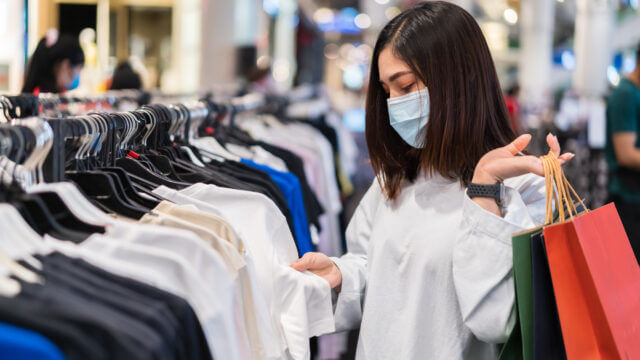
Heather Craig, Retail Brand and Customer Experience Expert, shares her personal insights on retail, the Coronavirus pandemic and the impact of a positive returns experience on a customer’s Lifetime Value to a brand.
BACKGROUND and CAREER HIGHLIGHTS:
Heather Craig has led the charge for innovation across stores and ecommerce for global brands such as Tommy Bahama and The North Face.
Most recently, she created and launched the brick and mortar experience for the country’s largest online thrift store: ThredUp.
She has been awarded for her contribution to retail and ecommerce and recognized in the industry as a nominee for Outside Magazine 40 under 40! (crunchbase.com)
What are the main obstacles you’ve encountered with the current situation (Coronavirus Pandemic) as it relates to customers’ relationship with brands? How has the customer experience changed?
Heather: I think some of the big changes I’ve seen are customers are very aware of how brands have handled themselves during all of this. Whether it’s their own employees, their offices, the way they’ve handled their stores – it’s made customers even more aware of the brands they want to align with.
I think that it is the same brands that have really cared about their employees that have also made extra efforts to really keep the customers’ safety in mind and being mindful of the customers’ needs. Those are the ones that are seeming to rebound a little bit quicker.
When returning items, how do brands handle the optics of returns – quarantining items before releasing them back to be sold?
Doddle + KIOSK might argue that returning items effortlessly into a bin to be released by staff at regular intervals throughout the day or week is a perfect solution to this particular problem – for both retailers and shoppers.
Heather: It’s interesting: I think there’s always been this need where customers want to have a more seamless returns experience. Now, when people are trying to avoid going to too many places, customers are appreciating that they don’t have to drive all over the place to do their returns at different locations. It is that multi-tasking or time-multiplying effect. They just want to go run their errand and get back home. When it comes to returns, and the partnership with KIOSK, I can see that could be such a great benefit because if the customer is at one store, they can accomplish a few other things. Retailers must strive to make it simple and make everything happen in one location.
People still want to make a return. When they buy something, they want the ability to change their mind, but they don’t want to go through such hoops.
It is that multi-tasking or time-multiplying effect.
Brian Cornell, CEO of Target, in a recent interview (with the National Retail Federation) made the comment that safety in stores is at the center of this post-pandemic world. When it comes to merchandise changing hands either via the e-commerce shipping model or in-store, is it the responsibility of retailers to provide that comfort of safety to shoppers? What are some ways that stores can do that?
Heather: Customers are nervous when they’re going into the stores (some of them are, others might not be). But as a retailer or a brand, you have to create a consistent standard of safety across your organization. But doing it in a way that still feels somewhat fun, as fun as it can be. I think things like putting plexi up and wearing masks and limiting the number of people that go in – It’s hard to make that fun, but I think there are some great things coming out about what brands are trying to do to make it a little more interesting. Whether that’s doing doorstep drop off or curbside pickup. That extra step has changed the way people are interacting in a store now just because of that fear that they have.
The company itself does have a bigger responsibility. At the same time, I think there’s the element of people having the ability to self-regulate a little more. When I checkout I will hold the product with the barcode facing the cashier so that they don’t have grab it and scan it. I want to make it easier for them, just as they want to make it safer for me.
Eliminating any of the passing around of things is always going to make it feel safer to the customer. So if you have a return and you don’t have to have a lot of passing back and forth, if there’s a way to do that where it’s self-serve or more contactless, I think that’s what people appreciate, it’s probably what we need. I think it is on the companies themselves to make sure they are implementing options like that for the safety of the customer.
It’s having the options I think that customers appreciate more than anything.
Cornell also said that during the COVID pandemic, millions of Americans learned how to shop online.
I have personally seen skeptics resort to shopping online because they needed to. However, customer service and returns became a major pain point during the stay at home / safer at home orders. Do you think online shoppers will find it easier (would prefer) to return-in-store vs. through the post now that restrictions are letting up?
Heather: I think it’s different by category, and also by area. Everyone has so many unique needs. Whether they’re busy, they’re not busy, they have their kids with them – giving them options is always the best route. I may want to go to Target and return it myself, but if I don’t want to go in-store, I still have to return my item, I don’t want to be forced to do it one way.
People are still buying in stores. I was out last week and there was a huge line at Home Goods. It was the first day that they had opened. People still want to go buy and touch and feel things. Which is frightening when you think of everyone touching and spreading things around.
The majority of apparel is still bought in a physical store. Even if people are taking a giant leap to buying online, it’s still going to take time to fully get everyone buying everything online. Which I think Is an interesting challenge.
At ThredUp, you were charged with the mission of changing the way women think about secondhand and intended to convert skeptics by opening physical locations to see and feel products that are high quality and fashionable. What are shoppers missing out on by shopping online? Can they have both (do they need both) the online and the in-store experience?
Heather: The secondhand business is very different but it still comes down to trust. They want to trust that when they buy something, they’re getting what they paid for, whatever that might be.
There is this misconception around second-hand being dirty and used. The first goal was: We need to make this product look really great and new online. 30% of the inventory actually was new with tags because people buy so much stuff that they don’t actually use. But it became clear, the in-store experience was essential to converting skeptics. It turns out, it’s all about the lifetime value of the customer.
The reality of some of these businesses is – even if they do have physical stores, they still are going to need to drive their e-commerce business. Whatever they can do to get that customer into the e-comm flow, it is always going to be tremendously beneficial for them.
Maybe it’s not with the first purchase, but if there’s a way to get them comfortable with the online flow through the second purchase, that’s where you see the lifetime value come in for these brands.
When you led the effort to cross channels and bring an online retailer into brick and mortar (at ThredUp but also at The North Face), what were the main driving factors for that initiative? Where did you experience the most resistance from a customer experience perspective?
Heather: At the end of the day, the biggest driver was new customer growth. So even if an online business is very strong (or a store business is very strong) you can’t get to everyone with just one channel. Specifically, at ThredUp, a company will spend a certain amount of money to acquire new customers. They will look at the Lifetime Value of the customer and the acquisition cost. Acquisition does not always have to be through digital marketing tactics that drive them to the website. It could be something completely different. A lot of people do want to interact in real life. They don’t always just want to be on their phone. Especially when it’s an unknown brand that they haven’t heard of before.
Once you get past that first or second in-store experience, then they are comfortable getting online. I think that’s what they really saw as the way to grow new users and to grow their brand awareness. Maybe the stores themselves are not profitable but the lifetime value of that customer is significantly higher when their first experience was in a store vs. starting online.
I think the same is true with returns. When you’re helping a customer with a return of their first order, vs. their 10th order – it’s very different. They have a different expectation. That’s where unique thinking is important.
I spent a lot of time working on returns as a pain point for retailers and particularly for physical stores. I remember when e-commerce first started. The customers would bring their return from online into the store. The store would flip out. They would be frustrated and wonder “why are they coming in?”
Over time that has changed because they realized “You just got them to come back!” how lucky are you that they are coming back and you have a chance to “wow” them with a simple experience so that they have no problem coming back again. That’s where you see returns are a critical part of the experience that retailers need to elevate and prioritize.
I’ve done deep analysis to understand the customer’s first purchase that results in a return compared with subsequent purchases that result in a return. You can see a significant increase in that customer’s value to the brand if they make their return positive. Maybe that means you lose money on the first return. So be it! You make it up on their subsequent purchases.
This unprecedented time brings to mind this quote
“There are decades where nothing happens; and there are weeks where decades happen.”
– Vladimir Ilyich Lenin
Retail business has gone through this several times in recent history: Brief periods of major change.
Back in 2017, while you were creating and launching the brick and mortar experience for the country’s largest online thrift store; ThredUP, some other brands were experiencing a “retail apocalypse” – stores were closing, brands were panicking over the move to e-commerce. Many retailers shifted focus to building upstream distribution centers. Others pivoted their business model towards service.
And that was nothing compared with the shift that stores are making now to accommodate digital shopping and understand what place brick & mortar holds in the consumer environment.
So will it stick? Does brick & mortal hold a lasting place in the consumer environment? Or will the fact that shoppers have “learned” to shop online change shopping habits in the long-term?
Heather: It’s an interesting question, I always hear people say “Stores aren’t going anywhere. They’re not going away.” I think that may be true but I think their purpose might change dramatically. They might just end up being a spot to pickup and drop-off things. But there will always be that element of customer service and caring about the customer that you just can’t get from digital.
There is an element of being in a physical place that you enjoy being in with people you’re comfortable being around; I still think it’s going to have value. Especially as we’re going through a worldwide pandemic, these little highlights are what people are getting so excited about.
We’ve seen stores that have put returns at the center of their business model. REI comes to mind as well as Costco. More often than not, returns are an afterthought. What effects, if any, does putting a focus on returns have on brand image?
Heather: It feels a little sneaky when you buy something and it is so hard to return it, it feels like the company is hiding the returns process. More often than not, people complain about the negative return experience. When you look at the biggest pain point from online orders specifically that come through call centers, it is the returns that are the biggest complaint that you hear about. Whether its “I couldn’t find the label?” “how do I do the return?” “where do I drop it off?” …
There are endless questions. But oftentimes that is the customer’s first online purchase. Once they get past that first purchase, you kind of start training them to do it on their own. A lot of brands have made the strategic choice to forego the work involved to optimize the returns experience and I think that is a detriment to their business.
I think the biggest thing that has been very apparent to me, I wish more retailers would really take to heart to the returns side of things.
They will see how long-term it will benefit their business so much more to just make that simpler for the customer.
You’ve also been quoted as saying that for ThredUp “stores are just another portal to our site” Should that be the goal? To drive people online?
Heather: For a business like ThredUp that are operationally heavy, where all of their business is the platform that they’re building which is powering inventory coming in and inventory going out, it’s not going to ever be at that scale in a 1500 sq. foot store. So the only way to do it at the scale that they’re doing it is it has to go online. I think it’s very different for other retailers. In order for it to be most beneficial for a company like ThredUp, they’ve got to get those people online.
I started to think about how you could do lockers or drop off bins, especially when we did the partnership with Macy’s. Why not just put something at the Macy’s – it’s a ThredUp pop up shop where people just literally drop off their bags. That would be a great way to drive traffic to Macy’s. Even if someone that doesn’t shop at Macy’s knew that they could drop it off there and then they could go and buy something at Macy’s.
I think the biggest thing that has been very apparent to me, I wish more retailers would really take to heart to the returns side of things. They will see how long-term it will benefit their business so much more to just make that simpler for the customer. I get it, it costs money, it’s a pain. You have to spend extra to put an extra label in or whatever it is – but the net outcome of it is so much greater if you can provide a simpler way to do the returns. I think that there’s a big need to do a deeper dive into the analytics around the customer behavior – Return vs. don’t return, where the complaints come from. The brands that have dug into it are the ones that have made big changes to their return policy. They are seeing benefits.
It’s super important for a company to pivot and focus on returns and if they can do it with a solution provider that is experienced in it then that takes the legwork off of them to do it.
I feel strongly that more brands need to take this more seriously.




